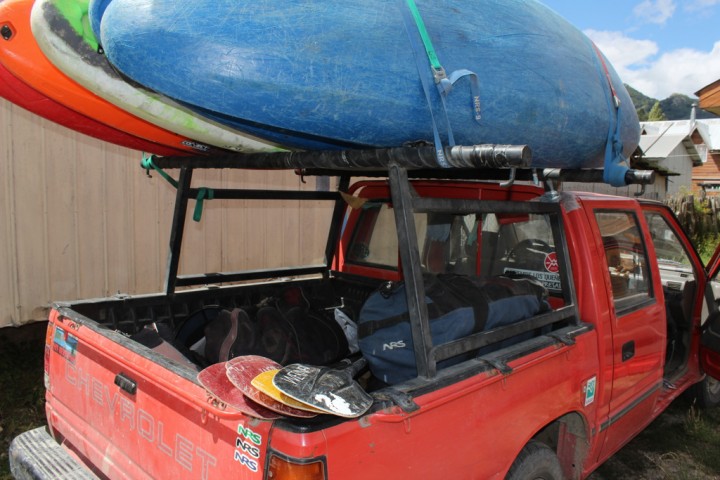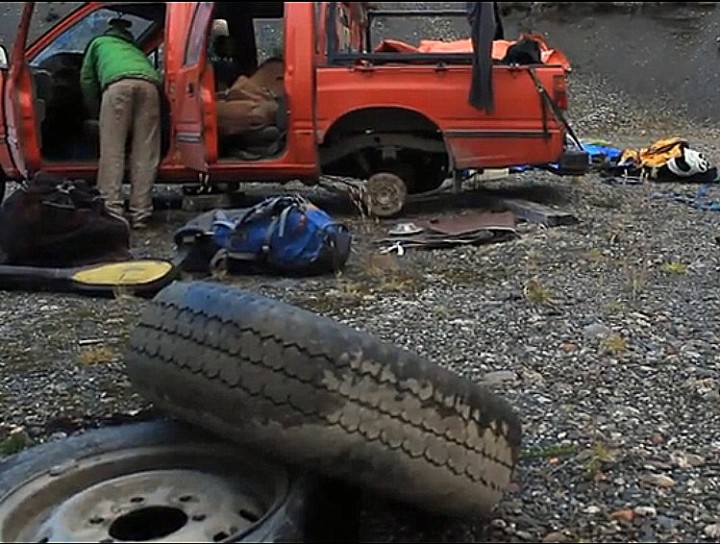Having recently returned from a winter spent paddling in Central and South America, our hometown hero, Kyle “Smitty” Smith, runs down the risks and benefits of purchasing a shuttle vehicle for your foreign paddling travels and shares tips for keeping your rig on the road and the man off your back.
I kick the tires. Richard pushes on the bumper. Rubber tread falls onto the ground and shocks squeak under the light pressure, visibly oozing fluid. Circling around the vehicle, we pretend like we know what we’re looking for. Apparently we think we’ll ascertain some unknown man-knowledge from kicking, pushing and grunting in this hot New Zealand driveway.
I can barely change my own oil.
The owner, in the most stereotypical kiwi accent possible, tries to convince us of the reliability of the car. “Oh brew! The toires are as sticky az bro!” Said “toires” resemble the head of Captain Jean Luc Piccard, BALD. He assures us that if we just switch the tires to opposing sides and degrease the leaky shocks, we’ll definitely be able to fool the trained specialists at the NZ Warrant of Fitness Department, whose job it is to keep vehicles just like this one off the road.
There are a lot of shady things going on here, but the giant subwoofer that comes with the ride would be so cool to blast when pulling up to the put-in. Never mind the fact that we just bottomed out pulling into the driveway, and that’s without four kayaks, coinciding boat owners, and associated river-soaked paddling gear. Okay, so maybe a lowered gangstermobile with blacked-out windows and a street-racing kit wasn’t the obvious kayaking rig. But, hey, we did buy groceries while we were on the test drive, so this car-shopping trip wasn’t…fruitless.
To date, I have crossed fuses, blown tires, popped dents out of rental vehicles’ bumpers, strapped loads well beyond the manufacturer’s recommended allowance to roof racks. (I assume three fully loaded kayaks exceeds the 75 lb. recommended load rating.) I’ve been associated with stealing fuel pumps off of wrecked Chevy LUVs in Chilean ditches to replace my own (allegedly), and I’ve hitch hiked to replace flats, and I’ve still managed to get to the airport on time more often than not. Buying a vehicle in another country is not always easy, nor is it always the smartest thing to do, but it has its perks. And, if you do it right, make smart choices, and have a little luck and a good attitude, it’s worth it.
Here is a short rundown of things to be sure of when purchasing a vehicle in another country, specifically Chile/Argentina, and some helpful hints to for keeping the man off your back and your “toires” on the road.
When considering purchasing a shuttle vehicle for your international kayaking trip, the first thing to do is assess your realistic needs. How long will you be in the country? What’s the public transportation like? Are you partaking in one-day gorilla-warfare hit-and-runs, where you and your buddies will be driving from huckfest to the cervezaria every day? Or is it massocistic multiday missions that you fancy? For multi-day missions, you’ll need less frequent shuttles, which will likely make it more cost effective to hire a shuttle driver. If you’re going the huckfest route and running shuttles daily, then you might consider buying a vehicle. (Unless you’re in Ecuador, in which case Abe Herrera with Boof Sessions will get you lined out with cheap shuttles every day, costing you $300, at most, for 30 days of paddling. Now that’s a deal.)
But before you pull out your wallet to purchase a rig, consider how much renting and insuring the vehicle will cost you for the amount of time you’ll be in the country. How many of your buddies are willing to chip in to help buy and insure it?
Also ask yourself if you can you take the hit if your Argentine shuttle-driving girlfriend rolls the truck off the side of the road. She walks away safely, but your newly purchased truck, like your relationship, is beyond hope and beyond reclamation. Now you’re eating ramen and marshmallows for dinner because your ticket back home is pushing up flowers at the bottom of a steep embankment. Especially after the engine, seats. wheels, lights, tie rods, and, yes, fuel pump, go missing, which they will. Now, you and crew are out 4k, and you’re getting into the nitty gritty of it and leaning heavily on the “good attitude.”
It can happen.
If it makes more sense to buy and insure a reliable vehicle that you may see no return on than to rent or hire transportation, then go for it. Now all you need is to find the right auto for the crew, retrofit it for maximum dirtbaggery, iron out the paperwork and hope for a little luck to keep the mechanical break-downs to a minimum.
Assume there will be breakdowns.
Upon setting out for a paddling pilgrimage (definition—a journey to a holy, special, or unusual place) to Southern Chile’s Rio Futalefeu, Baker and Bravo earlier this year, the more determined, and dare I say smarter, members of our crew began delineating costs and turning over stones in search of the vehicle that would likely live out its last days under the ownership of a group of selfish, fun-hogging gringos in Southern Patagonia.
Scarlett kept me up at night from worry that she might not make it to see another day. Nevertheless, I was losing sleep lying next to some of the most amazing rivers in the world, in places that I couldn’t have gone without her.
The ruddy Chevy LUV fired up in the streets of Pucon on the first…second…ok…third go. Good enough. It passed all of the man-grunting and kicking tests. The fluids seemed murky and the belts were a bit cracked—easy enough to fix. It was missing an integral piece, a kayak rack. No problem. The metal fabricator was just down the street, itching to weld something together wearing only a pair of $1 sunglasses as eye protection. What could go wrong? The crew brainstormed the best kayak rack known to man, changed the belts, replaced the fluids, greased the bells and lubed the whistles. Scarlett, the little red LUV, was ready to go adventuring after a stop off at the registry.
With some help from our local Chilean guide, Hernan Barria, here’s the step-by-step process we learned for navigating the Chilean version of the DMV.
Obtain a RUT Number
Before purchasing a vehicle in Chile, one needs to attain a RUT number, similar to a social security number. You can get this at the Registro Civil, the equivalent of your local courthouse. Now you can legally purchase a vehicle.
Check the Paperwork
Once you’ve found a suitable vehicle, make sure it has the Permiso Circulacion. This document proves that your soon-to-be-shuttle rig has insurance. It should also have a Revision Technica which verifies that the vehicle has been cleared by technicians during the annual vehicle inspection. (Hopefully, this means your vehicle is somewhat sound for travel.)
Once you own the car, make sure to keep the Revision Technica up to date. Futalefeu, being extremely rural, has technicians that visit at awkward times throughout the season, often not during paddling season. It’s best to get this checked up if you are near a larger city throughout your pilgrimage. The Registro Civil can point you in the right direction for attaining both the revision and insurance, however, both should be current from the previous owner. Double check this and call “FOUL” if this is not the case.
Complete the Transfer
Once you’ve made sure everything is in order, you can head back to the Registro Civil with the seller of your soon-to-be startship traveler to attain the ownership papers and bill of sale, or Padron. As the buyer, you’ll be charged a transfer fee which needs to be paid in the bank and the registro civil. The fees for our 1995 Chevy LUV came to about 20,000 Chilean Pesos at the bank and around 27,000 Chilean Pesos at the registro civil. That’s roughly $90 U.S. The older the vehicle, the less costly the fees.
Congratulations on your purchase. You have now effectively doomed this vehicle to a life burdened with dirtbags, sloppy neoprene and smelly GORE-TEX.
Some More Hot Tips
It’s a good idea to put all of the crew members’ names on a Carta Poder. In the situation that the person whose name is on the Padron leaves before everyone else (maybe they blow their shoulder and need to head home), anyone listed on the Carta Poder will be authorized to sell or trade the vehicle.
If the crew plans on cutting through Argentina without the owner, you will need to attain an Autorizacion. These can both be found and processed at the notaria for $10 U.S.
Oh, and stay current on the insurance and Revision Technica. Buy your rig in Chile, not Argentina — it’s cheaper. Change all of your belts and fluids the same day of purchase. Drive slow to go fast.
I now find myself back home in Idaho after having sold Scarlett. Along with countless shuttles up and down the rutted-out road beside the Rio Futalefeu, she made a mission to The Baker, Bravo and back again. She had three flat tires and dropped a rotula on the brutal Southern Patagonian road, the Cara Terra Austral, which is gravel for hundreds of miles. Her muffler fell off, shortly followed by the bumper. But, with just a touch of bad Spanish, some elbow grease and luck, the 1995 Chevy LUV survived four months of whitewater kayaking glory and provided more campfire stories than we will remember.
Scarlett was a labor of love. She even kept me up at night from worry that she might not make it to see another day. Nevertheless, I was losing sleep lying next to some of the most amazing rivers in the world, in places that I couldn’t have gone without her. With some smart choices, a little luck and a good attitude you can find your own Scarlett.
Suerte!


